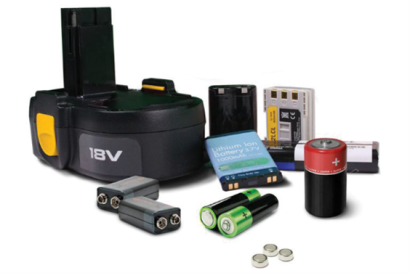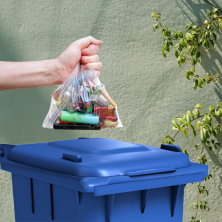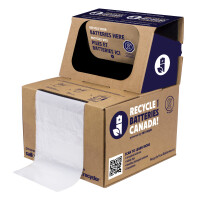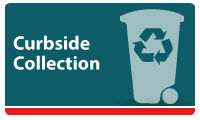Battery Recycling
Batteries are considered household hazardous waste and should never be thrown into the garbage. Fortunately, there is a convenient and responsible way to recycle your used batteries at the end of their life, to keep harmful chemicals out of landfill and protect the environment.
The District of Squamish works with the Recycle Your Batteries, Canada! program to collect used batteries for recycling through two convenient programs:
- Semi-annual curbside collection
- Year-round drop-off program
Accepted batteries
The curbside and drop-off programs, both accept dry cell, single use & rechargeable batteries including:

- Standard AA, AAA, C, D, and 9-Volt (both alkaline and heavy duty)
- Lithium single-use batteries, including button and coin cells
- Nickel Cadmium (Ni-Cd)
- Nickel Metal Hydride (Ni-MH)
- Lithium Ion (Li-Ion)
- Nickel Zinc (Ni-Zn)
- Small Sealed Lead Acid
Please note that the following types of batteries are not accepted through these programs.
- Damaged or defective dry cell batteries
- Wet cell and industrial batteries (e.g. car batteries, marine batteries)
If you are in possession of these types of batteries, please use the Waste Wizard to find out how to recycle them locally.
How to safely collect and store used batteries
Batteries don’t fade all at once, but you don’t need to make a special trip to a recycling depot each time you replace a battery. Simply follow these steps to store your batteries safely, so you can conveniently recycle them together.
- Collect batteries in a non-metal container – like a glass or plastic jar
- Some batteries require precautions because they can cause sparks when they come into contact with metal or other batteries. You can help prevent sparks by protecting the terminals in one of two ways:
- Option 1: Tape terminals
Cover the terminals with clear packing tape, duct tape or electrical tape. Be sure not to cover the brand name or chemistry on the label. - Option 2: Bag and seal
Place each battery in a clear, sealable/zipped bag.
- Option 1: Tape terminals
- Once you have collected your batteries and protected the terminals, store your battery-safe container in a cool, dry place, away from the sun until ready for recycling.
Recycle Your Batteries, Canada! recommends that you arrange to dispose of your used batteries every three months to avoid corrosion. So take advantage of curbside collection programs, or drop off your batteries at a retailer or Recycling Depot at any time of the year.
For more information on battery safety visit Recycle Your Batteries, Canada: Battery Safety.
Curbside battery collection
 Squamish residents can take advantage of a pilot program to have their batteries collected on two occasions this year:
Squamish residents can take advantage of a pilot program to have their batteries collected on two occasions this year:
- Week of April 21 - 25, 2025
- Week of November 3 - 7, 2025
To prepare your batteries for collection, simply follow these simple steps:
- Place acceptable batteries into clear, sealable plastic bags
- Place the sealed battery bags on top of your recycling tote* on your regular collection day.
Battery collection takes place on your regular garbage and organics collection day that week. Place your batteries on top of your recycling tote and leave it curbside.
* Recycling totes will not be serviced. They are used as an indicator that this household is participating in the battery recycling initiative.
Year-round drop-off program
 You can conveniently drop off your batteries for recycling year-round at many locations throughout Squamish. You can find them at municipal facilities, government buildings and retail stores throughout Squamish.
You can conveniently drop off your batteries for recycling year-round at many locations throughout Squamish. You can find them at municipal facilities, government buildings and retail stores throughout Squamish.
To find your nearest drop-off location, please visit Recycle Your Batteries, Canada!
What happens to my batteries after collection?
Batteries collected at curbside are picked up and transported to a facility where they are sorted according to type, size, shape and chemistry. Sorted batteries are then sent to processors where they are broken apart through a mechanical separation process. The battery components are separated, and materials are reclaimed for use in the manufacturing of new products such as silverware, pots & pans, golf clubs and new batteries.
Images courtesy of Call2Recycle Canada Inc. © Copyright 2024 Call2Recycle®. “Recycle Your Batteries, Canada! Powered by Call2Recycle”, the battery and leaf logo and related marks are trademarks of Call2Recycle Canada, Inc., used under licence.
Curbside Collection FAQs

Collection schedule and electronic reminders